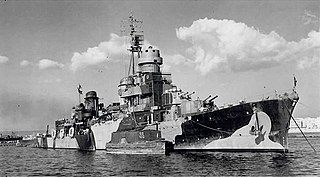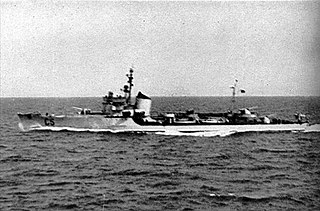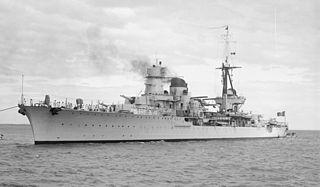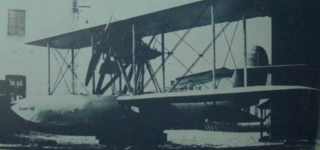
Paolo Camillo Thaon, Marquess of Revel, latterly titled with the honorary title of 1st Duke of the Sea, was an Italian admiral of the Regia Marina during World War I and later a politician.

The Capitani Romani-class was a class of light cruisers acting as flotilla leaders for the Regia Marina. They were built to outrun and outgun the large new French destroyers of the Le Fantasque and Mogador classes. Twelve hulls were ordered in late 1939, but only four were completed, just three of these before the Italian armistice in 1943. The ships were named after prominent ancient Romans.

The Spica class were a class of torpedo boats of the Regia Marina during World War II. These ships were built as a result of a clause in the Washington Naval Treaty, which stated that ships with a tonnage of less than 600 could be built in unlimited numbers. Thirty-two ships were built between 1934 and 1937, thirty of which entered service with Italy and two which were sold to the Swedish Navy in 1940. The two units in Swedish service were classed as destroyers until 1953, then re-classified as corvettes. Although commonly referred to as torpedo boats due to their smaller displacement, the Spica class armaments were similar in design to destroyers, and were intended for anti-submarine duties, although they often had to fight aircraft and surface forces as well. Twenty-three vessels were lost during World War II.

Raimondo Montecuccoli was a Condottieri-class light cruiser serving with the Italian Regia Marina during World War II. She survived the war and served in the post-war Marina Militare until 1964.

Italian-occupied France was an area of south-eastern France and Monaco occupied by the Kingdom of Italy between 1940 and 1943 in parallel to the German occupation of France. The occupation had two phases, divided by Case Anton in November 1942 in which the Italian zone expanded significantly. Italian forces retreated from France in September 1943 in the aftermath of the fall of the Fascist regime in Italy, and German Wehrmacht forces occupied the abandoned areas until the Liberation.

Ernesto BurzagliCB GCMM GOA was a prominent figure in the Kingdom of Italy during the early 20th century. During a lifetime career in the Italian Royal Navy, he rose to the rank of Admiral and Chief of Staff. In 1933, King Victor Emmanuel III appointed Burzagli as a Senator in Rome.

The Mechanized Brigade "Aosta" is a mechanized infantry brigade of the Italian Army based on the island of Sicily. The Brigade is one of the oldest of the Italian Army and the name connects the brigade to its original area of recruitment the Aosta Valley and therefore the brigade's coat of arms is modeled after the coat of arms if Aosta. The brigade is part of the Division "Acqui".

The 131st Armoured Division Centauro was an armoured division of the Italian Army during World War II. It was formed in February 1939, by upgrading the 1st Armoured Brigade. It took part in operations in Albania, Greece and Yugoslavia before returning to Italy. Sent to North Africa in August 1942, it surrendered in Tunisia on 13 May 1943.
Piero Foscari was an Italian merchant ship and then auxiliary cruiser of the Regia Marina.

The Mechanized Division "Folgore" was a mechanized division of the Italian Army. Its core units were three mechanized brigades. The brigades headquarters was in the city of Treviso.
Mario Aramu was an Italian aviator.

Operation Scylla on the night of 17/18 July 1943, during the Second World War was the transit of the Regia Marina Capitani Romani-class light cruiser Scipione Africano. The cruiser sailed from La Spezia in the Tyrrhenian Sea to Taranto in the Ionian Sea during the Allied invasion of Sicily.

Bruto Brivonesi was an Italian admiral during World War II.
The Grillo class was a class of torpedo-armed motorboats in service with the Regia Marina during the First World War. The notable feature of these vessels was that each was equipped with a pair of spiked continuous tracks, intended to allow them to climb over harbour booms and attack enemy shipping at anchor. In 1918, two attempts to use them to penetrate Austro-Hungarian harbour defences both ended in failure.

The CANT 13 was an amphibious aircraft designed for use on Regia Marina ships in response to a 1925 competition.
With the 1975 reforms the Italian Army abolished the regimental level and replaced it with brigades made up of multiple arms. During the reform the army disbanded 48 regimental commands and reduced its force by 87 battalions. A further ten regimental commands were used to raise ten new brigade commands. Ten training centers, which for traditional reasons had carried the names of regiments, were also disbanded. The reduction in units also allowed to mechanize most of the remaining units in Northern Italy and Italy's defense strategy changed from a hold-at-all-costs territorial defense to one of mobile warfare.

Freccia was the lead ship of her class of four destroyers built for the Regia Marina in the early 1930s. Completed in 1931, she served in World War II and previous conflicts.

Scipione Africano was an Italian Capitani Romani-class light cruiser, which served in the Regia Marina during World War II. As she commissioned in the spring of 1943, the majority of her service took place on the side of the Allies - 146 wartime missions after the Armistice of Cassibile versus 15 before. She remained commissioned in the Italian navy after the war, until allocated to France as war reparations by the Paris Peace Treaties of 1947. Scipione Africano was decommissioned from the Marina Militare in August 1948 and subsequently commissioned into the Marine Nationale as Guichen, after briefly being known as S.7.
The following is the structure of the Italian Navy as of June 2020. It is considered a multiregional and a blue-water navy.
The Cannone da 152/50 or 152/50 A. Mod. 1918 was a heavy naval gun, designed in the United Kingdom and produced under licence in Italy. It was used as coastal artillery during the Second World War.











